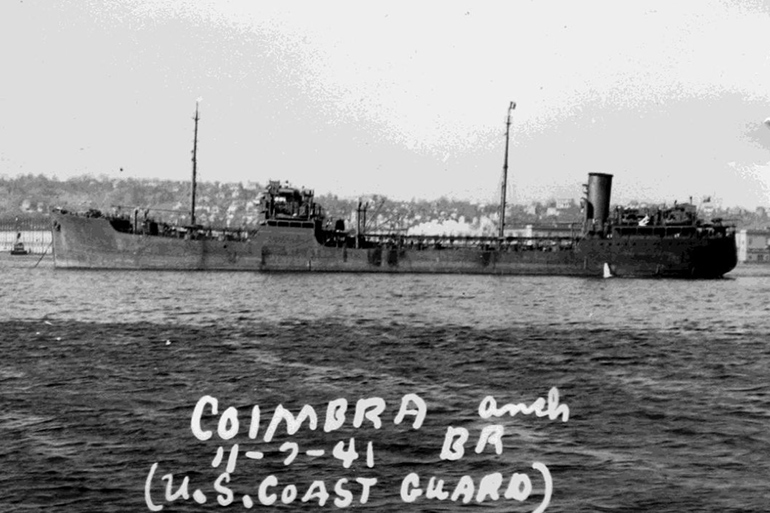Nothing Goes Away: WWII-Era Tanker Coimbra Leaking Oil off Shinnecock

The attack on Pearl Harbor on December 7, 1941, marked America’s entry into the Second World War. Within days, we had declared war not only on Japan but also on Germany. With our entry into the war, there was little doubt that the U.S. and its allies would prevail. However, after Pearl Harbor, the American Navy was so crippled, its ship-building operation would need almost an entire year before Naval vessels could mount a challenge to the German U-boats that roamed the Atlantic Ocean, torpedoing merchant ships and tankers bearing the flags of England, America and any other of its allies, almost at will.
Not only that, we couldn’t even track where the German U-boats were. German submarine commanders during that one-year period referred to their job sinking merchant ships as “the happy time.” It’s in all the journals they kept. And the Germans kept records of everything.
Here in the Hamptons, the most famous of all World War II stories concerned the arrival of four Nazi saboteurs onto a beach in Amagansett one foggy night, bringing in with them boxes of high explosives, which they buried in the sand. They came in a rubber boat rowed by Nazi sailors from a Nazi U-boat at 1 a.m. in the morning on June 23, 1942, just six months after Pearl Harbor. No ships encountered them. But a random encounter did take place once they came ashore to the beach.
A Coast Guardsman walking the beach at Amagansett, looking out for Nazi intruders—civilians were not permitted on the beaches at night as a result of this campaign, and the Coast Guard was enforcing it—encountered the foursome and talked briefly to one of them. This German, who spoke perfect English, offered a bribe of $350 to the Coast Guardsman if he would keep to himself what he was seeing. The Coast Guardsman took it, but then ran through the fog back to the Amagansett Coast Guard station to immediately report that Germans had landed. The Army and Navy soon arrived and the explosives were discovered, but the saboteurs had left the beach and were not found—until 10 days later, when their leader turned the others in after securing a meeting with the FBI in Washington.
Although this story is the most well-known of those war stories, there is another tale of the Nazi U-boats a few miles off Southampton, which has led this week to the employment by the Coast Guard of a company that sends divers down to the sea bottom to investigate shipwrecks. Twice since 2016, the National Oceanic and Atmospheric Administration notified the Coast Guard that this particular shipwreck—a British oil tanker called the Coimbra, sunk in January 1942 by a U-boat just five weeks after Pearl Harbor—appeared to be the source of oil slicks that have appeared on the ocean’s surface offshore of the Hamptons.

Beginning last Sunday and through to May 30, mariners have been told to stay at least 500 yards away from this operation, where divers from the Resolve Marine Group of Florida have a ship anchored over this wreck. It is their intention, at the end of the month, to be able to determine if this 70-year-old ship, bearing 2.7 million gallons of heavy lubricating oil when sunk, has deteriorated enough to need serious attention and a possible pump out of any remaining oil.
It was believed, considering what happened on that January night in 1942, that almost all the oil on board spilled out or caught fire and was consumed after the torpedoes hit. Indeed, this naval assault was so intense that residents of the Hamptons, seeing flames and fire off in the Atlantic that night, called the authorities to report that another ship seemed to have gone down. Such sightings were not uncommon up and down the Atlantic coast.
Franklin D. Roosevelt and Winston Churchill, during the war and later, both wrote they believed that with the United States entering the conflict, eventual victory was certain. But they also both wrote that in 1942 they were very frightened with what was happening in the Atlantic with the U-boats sinking so much of the American shipping bound for England that year. England stood alone against Hitler, the conqueror of Europe, at that time. It was desperate for supplies and would starve to death if supplies were not to come. America had been supplying England with everything it needed beginning from when the war in Europe began, but the onslaught of the U-boats in 1942 was a disaster.
When the totals were added up every month during that one-year period, it was found that more ships were being sunk than could be built to replace them. If that were to continue, in the end, in spite of the odds, Hitler could win anyway. Their fears ended in 1943 when newly built American ships came down the ways by the thousands and began relentlessly attacking the U-boats. Methods were also found to be able to track them. The threat was over by 1944.
The attack on the Coimbra has been fully documented, not only from American war records but also from German war records. The Coimbra, a five-year-old tanker flying the British flag, had filled its hull with all this oil from a refinery in Bayonne, New Jersey. Its captain, John Patrick Bernard, and its 45-man crew intended to sail along the south coast of Long Island, then head north, hugging the coast until Halifax, Nova Scotia, before finally heading across the North Atlantic to Britain. It wasn’t even 24 hours out of port when it met its fate.
German U-boat 123 was patrolling west to east along the south coast of Long Island when at 9 a.m. a crew member sighted the stern lights of what turned out to be the slow-moving Coimbra, heading in the same direction directly ahead of them. The information was swiftly delivered to Captain Reinhard Hardegen. Hardegen ordered everyone to their station, completed a dive, raised the periscope and at a signal fired a single torpedo at the Coimbra.
The torpedo hit the starboard side, just behind the engine room, and immediately there was a tremendous explosion followed by an uncontrolled and spectacular fire on the sea’s surface. The ship trembled and veered out of control, losing power and beginning to sit lower in the water.
Fifteen minutes after the first torpedo, Hardegen ordered a second torpedo fired, and this time the Coimbra stopped dead in the water and sank almost entirely, just an air bubble beneath the bow keeping that part of the ship above the waterline.
It all happened so quickly, the American merchantmen did not even have time to launch the five lifeboats that might have saved them. The crew abandoned ship by leaping into the cold sea before the ship went down. Nine of them climbed aboard two rafts and were soon found and rescued by sailors in a whaleboat from the USS Mayrant. Twelve other crewmen swam over to an upside-down lifeboat, managed to right it, and climbed aboard.
But it soon drifted away, and because the waves occasionally broke over it, the men were unable to fully bail it out and so sat in freezing cold water for the next 12 hours. Ten of them, including the captain, died of the exposure. Two were rescued by sailors from the USS Royan that evening. The rest of the crew drowned. Ten survived, 36 died.
Hardegen wrote in his diary, “These are some pretty buoys we are leaving for the Yankees in the harbor approaches as replacement for the lightships.” And he left the scene.
Eventually, the Coimbra sank, not far from where it was torpedoed. It remained a sunken wreck, a favorite of deep-sea fishermen who find many such wrecks to be home to schools of fish.

Now, 75 years later, it is being inspected again. Neither of the two oil slicks seen by satellites made their way to the beaches of the Hamptons or any other beaches, and there does not appear to be any danger that any additional oil of any large quantities might have come through a rusted seam after so many years.
But we have to wait and see.
It’s often said by environmentalists that there is no longer any “away” when you throw something away. It just goes to a new place. And it can come back to haunt us.



